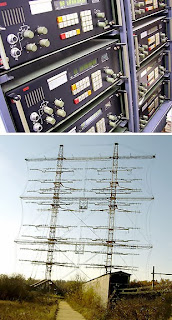On this occasion here in Wavescan, we
examine the multitude of QSL cards that Radio Sofia in Bulgaria has issued over
the years. The Indianapolis Heritage
Collection contains more than 130 QSL cards in various forms from the Bulgarian
shortwave stations, with an additional pile of uncounted letters and greeting
cards.
Radio
Sofia was noted in earlier years as a prolific verifier of listener reception
reports, though they did operate under their own distinct procedures that were
a little different from what other major stations had implemented. In earlier days, Radio Sofia shortwave
requested listeners to submit a sequence of reception reports within a stated
period of time, and these reports would then be verified by a series of six QSL
cards in a progressive sequence.
After
six QSL cards had been sent to the listener, then a Diploma was available; and
there were three progressive diplomas, Bronze, Silver & Gold. In order to obtain a Gold Diploma, at one
stage it was necessary for the listener to send in a total of 63 reception
reports within a period of somewhere around 70 weeks, a total time period of
nearly 1½ years.
However,
Radio Sofia did acknowledge many reception reports with the regular processing
of QSL cards that were not linked to the Diploma system. In addition, they also sent out New Year and
Spring greeting cards, picture cards of Bulgaria, and letters of greeting that
described various events and places of interest in their country.
The earliest QSL
response from Bulgaria in the Indianapolis collection is a self prepared QSL
card verifying the reception of station LZA on 14970 kHz on Sunday September
27, 1936. This card was addressed to a
listener in Canada.
At
the time, transmitter LZA was a low powered operation, emitting just 1½ kW from
a location near the railway station in Sofia.
This Morse Code transmitter had been recently modified for voice
transmissions, and it was in use for communication traffic as well as the
broadcast of radio programming, usually on Sundays. The listener in Canada was tuned to shortwave
LZA at the time when it was on the air with its regular Sunday programming, a
relay from the local mediumwave station in Sofia.
In
the era following the end of World War 2, the regular QSL card issued by Radio
Sofia was a
stylized card depicting a map of
Bulgaria with an artistic rendition of the popular Bulgarian Rose in a side
panel. This card was printed in pink and
a shade of gray.
Over
an extended time period of around a quarter century, the main emphasis on the
Bulgarian cards was shown with various forms of maps depicting the country’s
location in Eastern Europe. These cards,
always in color, also presented a radio tower with circular radio signals
radiating from it. At this stage, some
of these QSL cards were oversized, a little larger than the regular postcard of
that era.
The
first of the multi-series of QSL cards associated with their diploma system was
introduced in the late 1960s, and these depicted photographic scenes of tourist
interest in Sofia in full color. A side
panel presented the Radio Sofia motif, which at the time was a stylized block
printed in black, with a radio tower and the radiating radio signals in a
circular pattern.
A similar followup series of six cards showed additional tourist scenes
throughout Bulgaria, and the side panel showed the same stylized motif, though
the black identification block was smaller in size.
For
another period of time extending to another quarter century, several more
series of Radio Sofia shortwave QSL cards were prepared. Each of the cards in these series depicted
Bulgarian tourist scenes and the side panel in two, or perhaps three different
shades of brown over a period of time, presented an updated version of the
stylized Radio Sofia motif as a cluster of off center transmission circles.
Beginning in the late
1990s, a new series of very modernistic art paintings was prepared, and again
these were in full color. These cards
are intended to depict traditional scenes in Bulgaria: the performance of
modern music, modern depictions of ancient tribal art, and Radio Sofia itself.
Interestingly,
all of the above mentioned QSL cards, printed by the multi-thousand, are
presented in the English language.
However, some of the same QSL card designs were also printed with the
text in German, and some with the text in French.
Regional radio stations in Bulgaria
have also issued their own QSLs, in addition to the capital city based
international shortwave service from Radio Sofia itself. For example, QSL cards and sometimes letters
have been issued from the regional shortwave service Radio Varna near the Black
Sea coastal tourist area; likewise from the regional mediumwave station Radio
Zagora in the north east of the country; and also from the Home Service shortwave
station Radio Horizont with its own postal address in Sofia.
We
might also add that Radio Moscow has issued a few QSL cards for the relay of
its own programming on shortwave from the large shortwave stations in Bulgaria,
though the actual transmitter location has not always been correctly identified
on the card.
Then
too, the Voice of America has issued its own QSL cards from their head office
in Washington DC for their shortwave relay service via Bulgaria. We hold just one card from VOA Bulgaria. This card shows a brilliant morning sunrise
as seen through the curtain antennas at the VOA relay station in Greenville
North Carolina, and it verifies the reception of their relay via a 250 kW
transmitter on 13680 kHz at Plovdiv in Bulgaria.
We
plan to return to the radio scene in Bulgaria next month, when you will hear
the interesting story of special radio programming presented for the benefit of
shortwave listeners living in Bulgaria.
(AWR Wavescan/NWS 243)
